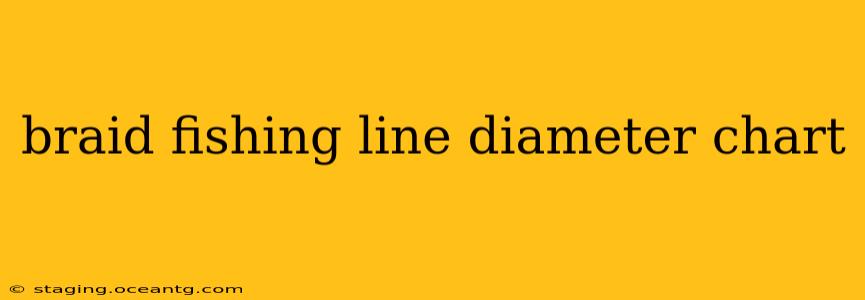Choosing the right fishing line is crucial for a successful fishing trip. Braid fishing line, known for its strength and sensitivity, is a popular choice among anglers. However, understanding braid line diameter is essential to match your line to your rod, reel, and target species. This comprehensive guide provides a braid fishing line diameter chart and answers frequently asked questions to help you make the best selection.
Understanding Braid Line Diameter
Braid line diameter is measured in millimeters (mm) or inches (in). Unlike monofilament, braid is constructed from multiple interwoven fibers, resulting in a smaller diameter for the same breaking strength. This smaller diameter allows anglers to use thinner lines while maintaining the strength needed to land larger fish. The diameter is crucial for several reasons:
- Rod Compatibility: Too thick a braid can overwhelm your rod, leading to breakage or difficulty casting. Conversely, a line too thin might break under strain.
- Reel Capacity: Thicker lines take up more space on your reel, reducing the overall capacity.
- Casting Distance: Thinner lines generally cast further, while thicker lines offer more resistance to wind and current.
- Sensitivity: Thinner lines provide better sensitivity, allowing you to detect subtle bites.
Braid Fishing Line Diameter Chart: (Approximate Values - Always Refer to Manufacturer's Specifications)
This chart provides approximate diameter to breaking strength relationships. Always consult the specific manufacturer's specifications printed on the spool for accurate information. Variations exist between brands and even different lines within the same brand.
| Diameter (mm) | Approximate Breaking Strength (lb) | Suggested Applications |
|---|---|---|
| 0.08 | 4-6 | Ultra-light panfish, finesse fishing |
| 0.10 | 6-8 | Light panfish, trout |
| 0.12 | 8-12 | Light to medium bass, walleye |
| 0.15 | 12-15 | Medium bass, walleye, pike |
| 0.18 | 15-20 | Medium to heavy bass, saltwater inshore species |
| 0.20 | 20-25 | Heavy bass, larger saltwater species |
| 0.25 | 25-30 | Large saltwater species, trolling |
| 0.30 | 30+ | Heavy saltwater species, offshore fishing |
Note: This chart offers general guidelines. Specific breaking strengths vary significantly between brands and line constructions. Always check the manufacturer's packaging for accurate information.
Frequently Asked Questions (FAQs)
What is the best braid line diameter for bass fishing?
The best braid line diameter for bass fishing depends on several factors, including the size of bass you target, the type of cover you're fishing, and your fishing style. For smaller bass in lighter cover, 0.12mm - 0.15mm might suffice. For larger bass in heavy cover, a thicker line like 0.18mm - 0.20mm might be necessary.
How do I choose the right braid line diameter for my reel?
Check your reel's specifications for line capacity. This information usually indicates how much line of a specific diameter the spool can hold. Use this information in conjunction with the manufacturer's information on your chosen braid to select a diameter that maximizes your reel's capacity without overloading it.
Does braid line diameter affect casting distance?
Yes, braid line diameter can significantly affect casting distance. Thinner lines experience less wind resistance, allowing for longer casts. However, very thin lines may lack the strength needed to effectively cast heavier lures. A balance is necessary to find the optimal diameter for your setup and target.
How does braid line diameter influence sensitivity?
Thinner braid line diameters generally enhance sensitivity. The reduced diameter translates to less line stiffness and resistance, allowing you to detect subtle bites more easily.
What is the difference between PE and lb test in braid?
PE (PolyEthylene) refers to the number of strands of polyethylene fiber used in the braid's construction. The PE number does not directly correlate to breaking strength in pounds (lb). Therefore, it is crucial to check the manufacturer's stated breaking strength in pounds to understand the line's overall strength.
By carefully considering your target species, fishing conditions, and equipment specifications, you can select the appropriate braid line diameter for optimal performance. Remember to always consult the manufacturer's specifications for accurate information on breaking strength and other relevant details.
